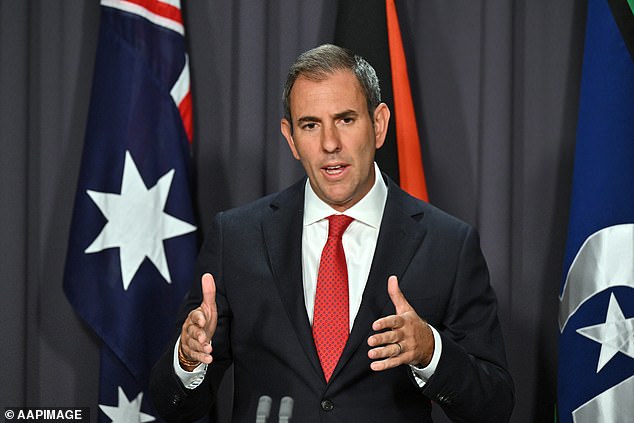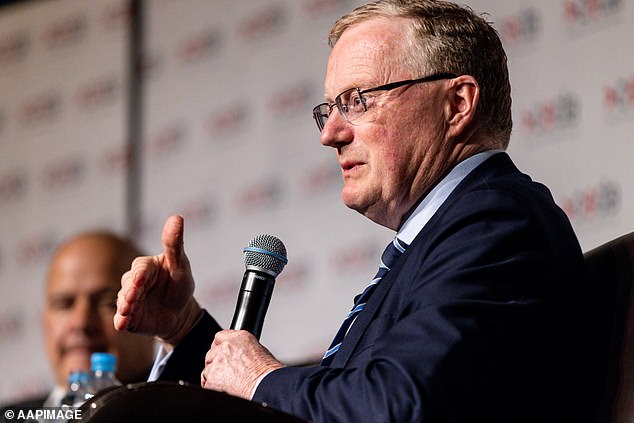Treasurer Jim Chalmers denies rising wages are to blame for inflation now at highest level sine 1990
>
Treasurer Jim Chalmers has hit back at the Reserve Bank chief for suggesting more generous wage increases are worsening inflation as home borrowers face even more rate hikes.
The federal Labor government has clashed with business groups and economists after the December quarter consumer price index rose 7.8 percent, the fastest annual pace since the early 1990s.
Now the Australian Council of Trade Unions is pushing for wages to outpace inflation, a development that could see a resurgence of the wage-price spiral that led to double-digit inflation four decades ago.
Dr Chalmers denied that rising wage levels were to blame for Australia’s worst inflation in 32 years, despite wages last year growing by 3.1 per cent, the highest level in nine years.
“Wage growth is starting to pick up in our economy, that’s a good thing, not a bad thing,” he said Wednesday.
‘It’s not the reason we have an inflation challenge in our economy.
scroll down for video
The federal Labor government has clashed with business groups and economists after the December quarter consumer price index rose 7.8 percent, the fastest annual pace since the early 1990s (pictured, a barista from Sydney makes a caramel latte)
“Our inflation challenge comes from a wide range of sources, but wage growth is not one of them.”
The treasurer’s downplaying of the link between rising wages and inflation puts him at odds with Reserve Bank of Australia Governor Philip Lowe, who in November warned of a 1990s-style wage and price spiral. 1970, despite having a compensation package of $1,076,029.
“I know it’s very hard for people to accept the idea that wages don’t rise with inflation…and people are experiencing a drop in real wages, that’s hard,” Dr. Lowe said.
‘If we all accept the idea that wages have to go up to compensate people for inflation, it will be painful. So better avoid that.
ACTU secretary Sally McManus wants minimum wages to rise to beat inflation, saying The Australian Financial Review price gouging, not wage increases, was fueling inflation.
“The current spike has been driven by rising prices, not by workers asking for the minimum they should be entitled to,” he said.
The last time a wage and price spiral gripped Australia in 1981, average full-time wages rose 14 percent while inflation hit 11 percent.

Treasurer Jim Chalmers has hit back at the Reserve Bank chief for suggesting more generous wage increases are making inflation worse.
Nonetheless, Australian workers, until the September 2022 quarter, had seen their wages remain below the long-term average of 3 per cent since early 2013.
“Indeed, for the better part of a decade, due to a deliberate policy of wage suppression and stagnation, ordinary workers have been left further and further behind,” said Dr Chalmers.
But that is slowly changing with unemployment in December remaining at a 48-year low of 3.5 percent.
Private sector workers are faring better with their pay levels rising 3.4 percent compared to just 2.4 percent for public sector professionals, data from the Bureau of Statistics of New York showed. Australia.
Retail workers had the best gain of 4.2 percent, after the minimum wage on July 1 rose 5.2 percent, then a level slightly above inflation.
This coincided with last year’s recreational and cultural inflation, which rose 9 percent.
The Commonwealth Bank’s Australian economics chief, Gareth Aird, noted that higher wage costs in the hotel sector were fueling service inflation, which was also likely to accelerate wage growth in 2023.

The treasurer’s downplaying of the link between rising wages and inflation puts him at odds with Reserve Bank of Australia Governor Philip Lowe (pictured), who in November warned of a price-wage spiral 1970s style.
“Much stronger service inflation impacts the outlook for wage growth,” he said.
“The rise in services inflation should see wage growth continue to pick up from here, as we and the RBA expect.”
Despite that, workers in all sectors are suffering a cut in real wages as wage levels do not keep pace with inflation, diluting their purchasing power.
Gasoline prices last year rose 13.2 percent after Russia’s invasion of Ukraine triggered sanctions that pushed up world crude prices, leading to prices of $2 per liter unleaded.
“We have an inflation problem in our economy because of the war in the Ukraine, supply chain pressures and some other problems that have been neglected for too long in our economy,” said Dr. Chalmers.
“We don’t have an inflation problem in our economy because people are earning too much.”
Inflation is well above the Reserve Bank’s 2% to 3% target, and economists at all the major banks expect another quarter-point increase on February 7 that would push the cash rate to a new 10-year high of 3.35%, up 3.1 percent.
That would add $93 to the monthly payments on an average $600,000 mortgage.
Home borrowers faced eight straight monthly rate hikes last year, following the end of the record low cash rate of 0.1 percent in May, marking the most severe pace of monetary policy tightening since the RBA first published a target cash rate in 1990.
